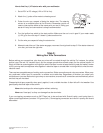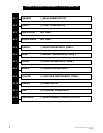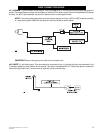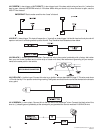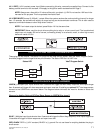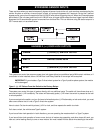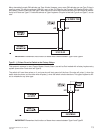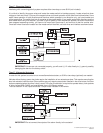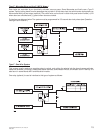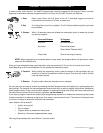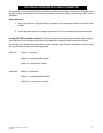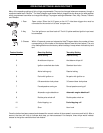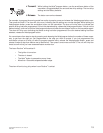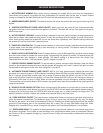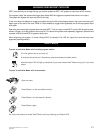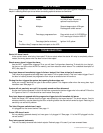
20 © 1999 Directed Electronics, Inc.Vista, CA
N430 9/99
1 – ACTIVE/PASSIVE ARMING: When active arming is selected, the system will only arm when the transmitter is
used. When set to passive, the system will arm automatically 30 seconds after the last door is closed. Passive
arming is indicated by the rapid flashing of the LED when the last protected entry point is closed.
2 – ARM/DISARM CHIRPS ON/OFF: This feature controls the chirps that confirm the arming and disarming of the
system.
3 – IGNITION CONTROLLED DOOR LOCKS ON/OFF: When turned on, the doors will lock three seconds after
the ignition is turned on and unlock when the ignition is turned off.The doors will not lock if the ignition is turned on
with the door open.
4 – ACTIVE/PASSIVE LOCKING: If passive arming is selected in step one, then the system can be programmed to
either lock the doors when passive arming occurs, or only lock the doors when the system is armed via the trans-
mitter. Active locking means the system will not lock the doors when it passively arms. Passive locking means that
the system will lock the doors when it passively arms.
5 – PANIC WITH IGNITION ON: This step controls whether or not the panic mode is available with the ignition on.
In some states, there are laws prohibiting a siren sounding in a moving vehicle. This feature makes the system
compliant with these regulations.
6 – DOOR LOCK PULSE DURATION: Some European vehicles, such as Mercedes-Benz and Audi, require longer
lock and unlock pulses to operate the vacuum pump. Programming the system to provide 3.5 second pulses, will
accommodate door lock interface in these vehicles. The default setting is .8 second door lock pulses. See
“Mercedes-Benz and Audi - 1985 and Newer (Type E)” diagram on page 15.
7 – FORCED PASSIVE ARMING ON/OFF: To use this feature, passive arming must be selected in step one.When
turned on, forced passive arming will ensure that the system will passively arm, even if a zone is left open or invalid.
Forced passive arming occurs one hour after the ignition is turned off.
8 – AUTOMATIC ENGINE DISABLE (AED) ON/OFF: AED is a full time, passive starter disable that works inde-
pendently of the security system. If AED is desired, the optional Starter Kill Relay must be installed.When turned on,
the H1/1 orange, ground when armed output will go active 30 seconds after the ignition is turned off. The LED will
flash at half its normal rate when the ignition is turned off to indicate that AED is on and will interrupt the starter in
30 seconds. AED does not occur in Valet
®
Mode and can be bypassed using the emergency override procedure.
The transmitter can be used to disarm AED, however, the system would have to be armed and then disarmed when
using the transmitter.
9 – DOUBLE PULSE UNLOCK OFF/ON: Some vehicles require two pulses on a single wire to unlock the doors.
When the double pulse unlock feature is turned on, the BLUE H2/C wire will supply two negative pulses instead of
a single pulse. At the same time, the GREEN H2/A wire will supply two (+) pulses instead of a single pulse. This
makes it possible to directly interface with double pulse vehicles without any extra parts.
10 – CODE-HOPPING
™
ON/OFF: The system uses a mathematical formula to change its code each time the trans-
mitter and receiver communicate.This makes the group of bits or “word” from the transmitter very long. The longer
the word is, the easier it is to block its transmission to the unit. Disabling the Code-Hopping feature lets the receiver
ignore the Code-Hopping part of the transmitter word. As a result, the unit may have better range with Code-
Hopping off. If a standard trinary remote is taught to the system, the Code-Hopping feature is not available.
11 – SIREN/HORN HONK: The system can be programmed to output pulses instead of a continuous output when
the system is triggered.This is useful to honk the factory horn in applications where a siren is undesirable. Remem-
ber that the unit is only capable of supplying 1 amp off current. A relay will be required to interface with most factory
horn systems.
FEATURE DESCRIPTIONS



